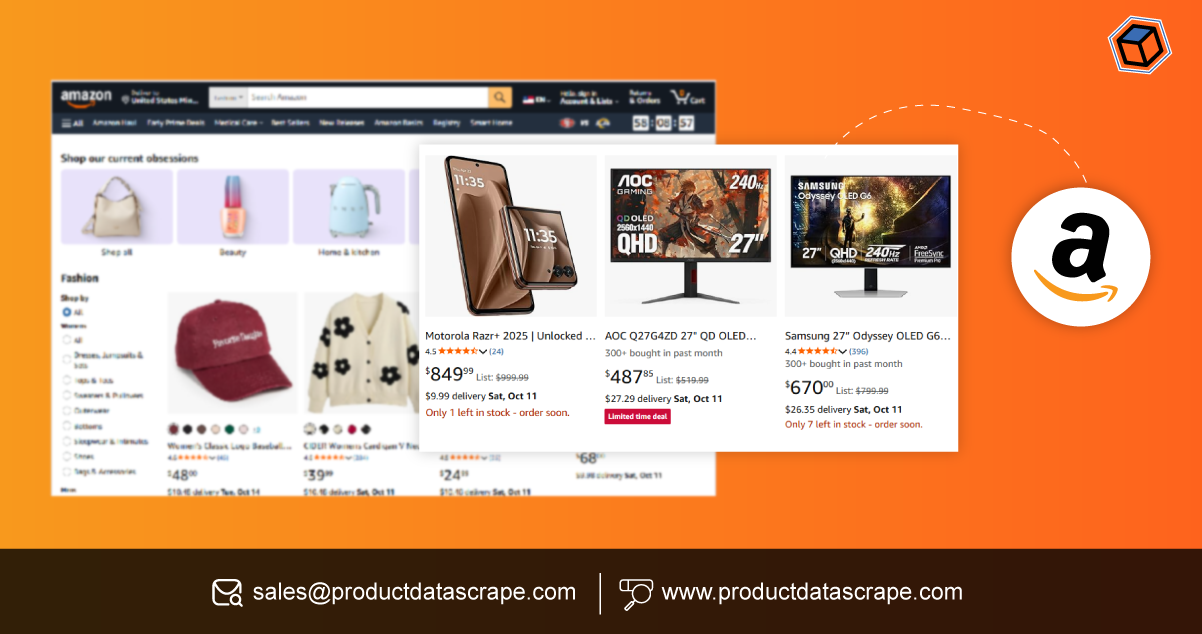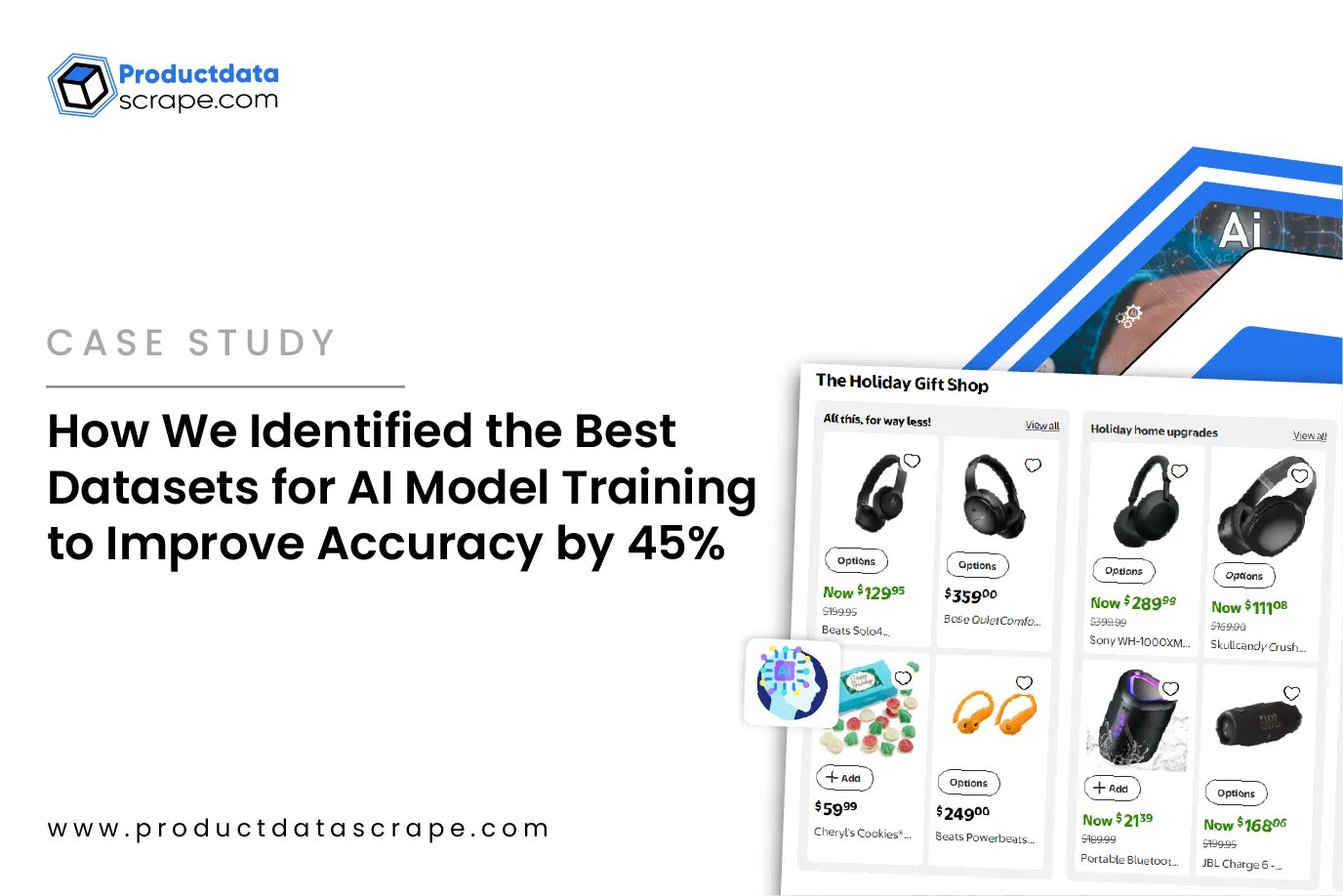
Introduction
In the ever-evolving e-commerce landscape, staying ahead of market trends and consumer
preferences is paramount. One effective strategy to achieve this is by scraping Amazon stock &
assortment data. This approach allows businesses to gather real-time insights into product
availability, pricing trends, and consumer demand, enabling them to make informed decisions and
optimize their product offerings.
Amazon, being a global retail giant, offers a vast array of products across various categories.
By analyzing the data extracted from Amazon's platform, businesses can identify emerging trends,
monitor competitor activities, and adjust their strategies accordingly. For instance, tracking
stock levels can provide indications of product popularity, while assortment data can reveal
gaps in the market or areas of oversaturation.
Moreover, leveraging tools like the Amazon Product Data Scraper can streamline the data
extraction process, ensuring accuracy and efficiency. These tools can collect a multitude of
data points, including product names, prices, ratings, and reviews, which are crucial for
comprehensive market analysis.
In the following sections, we will delve deeper into how scraping Amazon stock & assortment data
can drive category insights, focusing on various aspects such as pricing trends, product
availability, and consumer behavior.
Extract Amazon Retail Assortment Price Trends
Pricing is one of the most critical factors in retail strategy, directly
affecting sales, profitability, and competitive positioning. With the rise of e-commerce,
understanding pricing trends across categories has become more complex, especially on platforms
like Amazon, which hosts millions of products with constantly changing prices.
Scraping Amazon stock & assortment data allows businesses to gain a clear
picture of how products are priced over time, enabling them to make informed strategic
decisions. By collecting data on product availability, promotional activity, and price
fluctuations, retailers can detect trends that are otherwise hidden in the vast marketplace.
For instance, analyzing the pricing of electronics over the last five years
(2020–2025) can reveal patterns such as seasonal discounts during holiday periods, special
promotions during events like Prime Day, or price drops in response to competitor activity.
Using an Amazon product price dataset by category, businesses can calculate
average category prices, identify products that are consistently overpriced or underpriced, and
benchmark their offerings against competitors. For example, a table summarizing the average
price of laptops in 2020 was $650, rising to $700 in 2023, then dropping slightly to $680 in
2025 due to increased competition and new model releases. Such insights are invaluable for
businesses aiming to optimize their pricing strategies.
Moreover, monitoring retail assortment price trends allows companies to
forecast future pricing movements and make proactive decisions. For example, if a competitor’s
stock runs low, businesses can adjust their pricing dynamically to capture additional sales.
Similarly, if demand surges in a particular category, knowing the historical price elasticity
helps in maximizing revenue without alienating customers.
Leveraging extract Amazon retail assortment price trends also allows retailers
to implement pricing intelligence across multiple categories simultaneously, ensuring a
well-informed, holistic approach.
By combining historical pricing data with live stock monitoring, businesses can
develop predictive pricing models that align with consumer behavior. This not only improves
profit margins but also enhances customer satisfaction by offering competitive prices
consistently. Overall, extracting and analyzing pricing trends from Amazon provides retailers
with a tactical advantage, supporting data-driven decisions and helping maintain a leading edge
in a highly competitive e-commerce environment.
Amazon Category-Wise Product Listings Scraper
Understanding the breadth and depth of a category on Amazon is crucial for
businesses aiming to optimize their product assortment. The Amazon category-wise product
listings scraper is a specialized tool that allows companies to extract comprehensive data on
all products within a specific category, including product names, descriptions, images, ratings,
reviews, and stock availability. This provides unparalleled insights into how competitors are
positioning their products and which segments are most saturated or underserved.
By leveraging scraping Amazon stock & assortment data, businesses can
systematically map the category landscape and identify opportunities for growth. For example, in
the health and wellness category, a detailed scrape may reveal that protein powders and
supplements dominate 70% of the listings, leaving room for niche products like plant-based
alternatives or immunity boosters. Similarly, for consumer electronics, identifying gaps in
accessories, add-ons, or bundled products can guide strategic decisions on product development.
Analyzing category-wise product listings also allows businesses to monitor
product lifecycle trends. Products may initially attract attention but eventually decline in
sales due to competition, changing consumer preferences, or outdated features. By tracking
listings over time (2020–2025), companies can pinpoint trends like emerging subcategories or
shifts in product features that are becoming popular. For instance, tracking smartwatch listings
over the past five years may reveal an increased demand for health-monitoring features such as
heart-rate tracking and sleep analysis.
Additionally, the insights gained from Amazon category-wise product listings
scraper can inform inventory planning, pricing strategies, and marketing campaigns. For example,
understanding which products have the highest ratings and reviews enables businesses to
highlight similar features in their marketing messaging. On the other hand, identifying
low-stock or highly competitive listings allows companies to avoid oversaturated segments.
Ultimately, category-wise scraping provides a strategic view of the market,
enabling brands to make data-driven decisions that align with consumer needs. By extracting this
data efficiently, businesses not only save time but also reduce errors compared to manual
research. Integrating this approach with extract e-commerce category intelligence allows
companies to combine product, price, and review data into actionable insights, strengthening
their market positioning and supporting long-term growth.
Unlock category insights and outsmart competitors—use our Amazon
Category-Wise Product Listings Scraper to drive smarter business
decisions today!
Contact Us Today!
Amazon Product Price Dataset by Category
Having access to a structured Amazon product price dataset by category is a
powerful way to gain insights into pricing dynamics across different product groups. Pricing
data is more than just a number—it reflects supply, demand, competitor strategies, and market
positioning. By scraping Amazon stock & assortment data, companies can build datasets covering
thousands of products over multiple years, offering a rich foundation for analysis.
For example, examining pricing trends for home appliances from 2020 to 2025
could reveal that air fryers had an average price of $120 in 2020, increased to $150 by 2023,
and stabilized at $145 in 2025. Such a dataset allows retailers to understand the impact of
technological advancements, brand positioning, and consumer demand on pricing. A structured
Amazon product price dataset by category also facilitates benchmarking against competitors. By
comparing prices for similar products, companies can identify underpriced items that could
benefit from price increases or overpriced products that may require discounts to remain
competitive.
Beyond pricing alone, integrating stock and assortment data enhances
decision-making. For instance, if a competitor consistently maintains low stock levels on
high-demand products, a business can adjust its inventory and pricing strategy to capture
additional market share. Similarly, datasets can highlight promotional patterns, like the
average discount applied during seasonal sales or special events like Prime Day. Such historical
insights allow companies to forecast and plan future pricing strategies with confidence.
Furthermore, using scrape data from any e-commerce websites alongside Amazon
datasets enables cross-platform comparison, helping businesses identify market-wide trends and
opportunities. Combining pricing datasets with review analysis, using tools like scrape Amazon
reviews by category, adds another dimension, linking price sensitivity with customer
satisfaction.
In summary, an Amazon product price dataset by category is indispensable for
businesses seeking to optimize pricing, manage inventory, and maximize revenue. It transforms
raw data into actionable intelligence, supporting predictive analytics and strategic planning
across multiple product categories.
Scrape Amazon Reviews by Category
Customer reviews are an invaluable source of information, offering qualitative
insights into product performance, consumer satisfaction, and market gaps. By utilizing tools to
scrape Amazon reviews by category, businesses can aggregate thousands of reviews across products
and extract meaningful patterns. Reviews provide feedback on product quality, durability,
usability, and even emerging consumer trends that may not yet be reflected in sales data.
Integrating scraping Amazon stock & assortment data with review analysis
provides a holistic view of both supply and demand factors. For example, a product may have
ample stock but consistently low ratings, indicating quality issues or poor design. Conversely,
a high-rated product with limited stock may suggest an opportunity for increased inventory and
marketing focus.
Analyzing reviews across 2020–2025 enables businesses to track changing
consumer preferences. For instance, in the kitchen appliances category, reviews may reveal that
consumers increasingly value energy efficiency and multifunctionality, guiding future product
development. A systematic approach to scraping reviews also allows sentiment analysis,
highlighting whether the overall perception of a product or category is positive, neutral, or
negative.
By combining review insights with Amazon e-commerce product datasets and price
trends, companies can correlate pricing strategies with customer satisfaction. For example,
high-priced products with positive reviews may justify premium positioning, while negative
reviews at a similar price point may indicate the need for adjustments.
Furthermore, reviews often contain details about product use cases, common
complaints, or desired features that competitors have not addressed. Businesses can leverage
this information to innovate or differentiate their offerings. By extracting and analyzing this
rich feedback, companies gain a competitive advantage, making informed decisions that improve
customer satisfaction, brand reputation, and sales performance.
Extract E-Commerce Category Intelligence
Extracting e-commerce category intelligence involves gathering and analyzing
data across multiple dimensions—pricing, stock levels, reviews, product features, and
assortment. This comprehensive intelligence enables businesses to identify trends, forecast
demand, and make strategic decisions that enhance competitiveness. Leveraging scraping Amazon
stock & assortment data as a foundation, companies can build a full view of each category’s
performance over time.
For instance, analyzing electronics categories from 2020 to 2025 may reveal an
increase in smart home devices, highlighting a growth opportunity for retailers. Similarly,
observing fluctuations in category-level stock or assortment trends can indicate which products
are becoming obsolete and which are emerging as consumer favorites.
Integrating data from multiple sources, including extract Amazon e-commerce
product data, Amazon product data scraper, and extract Amazon API product data , businesses can
create dashboards that track performance metrics in real time. Metrics such as average product
ratings, price ranges, and review volumes provide insights into competitive positioning and
market gaps.
Category intelligence also informs assortment planning. If a certain
subcategory is underserved or shows rising consumer interest, businesses can introduce products
to fill the gap. Conversely, declining segments may warrant inventory reductions or phased
discontinuations.
By combining category intelligence with historical datasets, businesses can
perform predictive analytics, anticipating trends before competitors do. This proactive approach
leads to better inventory management, optimized pricing strategies, and higher customer
satisfaction.
Ultimately, extracting e-commerce category intelligence equips businesses with
actionable insights, enabling smarter decisions, faster responses to market changes, and
improved strategic planning across all product categories.
Gain actionable market insights—extract e-commerce category intelligence
to identify trends, optimize strategies, and stay ahead of competitors
today!
Contact Us Today!
Benefits of Scraping Amazon Stock & Assortment Data
The final section focuses on the cumulative benefits of scraping Amazon stock &
assortment data. Beyond understanding prices, reviews, and listings, businesses gain strategic
insights that drive decision-making across multiple domains. Data-driven strategies outperform
intuition-based decisions, especially in the competitive e-commerce environment.
One primary benefit is inventory optimization. By monitoring stock levels
across categories, businesses can forecast demand accurately, avoiding overstocking or
stockouts. For example, a product with consistently low stock across competitors may indicate
high demand, suggesting the business increase its inventory to capture market share.
Second, analyzing product assortments highlights gaps and opportunities.
Companies can identify underrepresented segments or features missing from competitor offerings.
Combining these insights with buy custom dataset solutions allows businesses to access curated
datasets tailored to their strategic needs, further enhancing decision-making.
Third, businesses can optimize pricing by leveraging insights from Amazon
product price dataset by category and real-time stock monitoring. Dynamic pricing models can
adjust in response to competitor moves or seasonal trends, maximizing revenue and maintaining
competitiveness.
Fourth, integrating review analysis through scrape Amazon reviews by category
strengthens product development. Understanding consumer pain points, desired features, and
emerging trends informs product enhancements or entirely new offerings.
Finally, adopting these data-driven practices enables companies to improve
marketing effectiveness, streamline operations, and make informed strategic choices. Utilizing
tools like Amazon product data scraper, scrape data from any e-commerce websites, and e-commerce
website data scraping ensures businesses have comprehensive, accurate, and actionable insights.
In conclusion, the benefits of scraping Amazon stock & assortment data are
multifaceted—enhancing pricing strategies, inventory planning, product innovation, marketing,
and overall competitiveness. Companies that adopt this approach gain a measurable advantage in
today’s dynamic e-commerce landscape.
Why Choose Product Data Scrape?
Opting for Product Data Scrape offers several advantages:
- Comprehensive Data Coverage: Access to a wide range of data points,
including
product details, pricing, reviews, and availability.
- Real-Time Data Extraction: Ensure up-to-date information for timely
decision-making.
- Customizable Solutions: Tailor data extraction processes to meet specific
business needs.
- Scalable Services: Accommodate growing data requirements as your business
expands.
- Expert Support: Benefit from a team of professionals dedicated to
assisting
you in leveraging data effectively.
Conclusion
In conclusion, scraping Amazon stock & assortment data is a powerful strategy
for businesses seeking to gain a competitive edge in the e-commerce market. By harnessing the
insights derived from this data, companies can make informed decisions that drive growth and
success.
If you're ready to unlock the potential of Amazon data for your business,
consider partnering with Product Data Scrape. Our expertise and tools can help you navigate the
complexities of data extraction and analysis, providing you with the insights needed to thrive
in the digital marketplace.
















.webp)
-01.webp)

.webp)
.webp)
.webp)